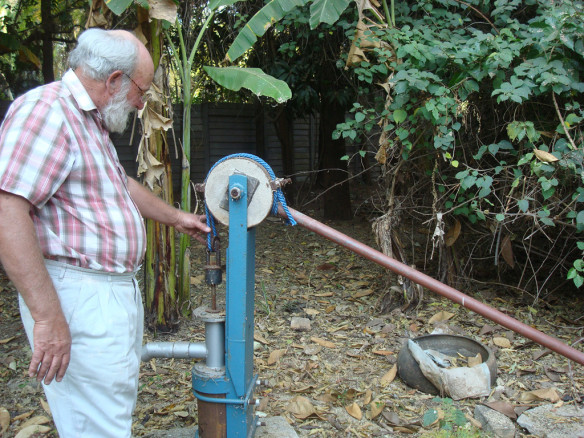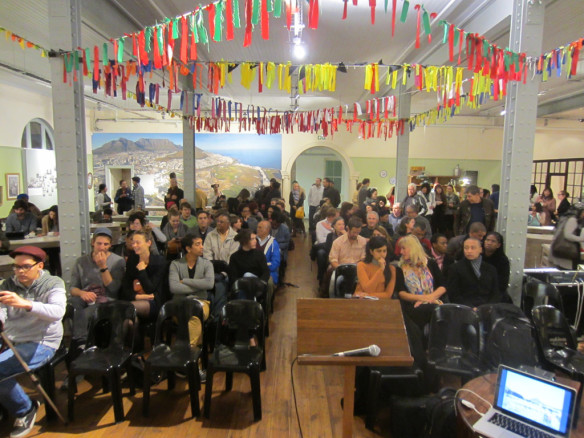I recently reread some writing I’d produced about the term ‘provocative technology’ in the first year or two of my PhD, reproduced below. Supported by other references to the term, I define provocative technology as an object or tool which has functions for the user but that also challenges the contexts of its use, and provokes questions and debate in wider audiences.
At one point I was going to make my PhD about provocative technology, identifying examples across disciplines and contexts and defining its principles. This turned out to be too broad a topic, and I shifted my attention to analysing examples in the field of ‘design for development’, the field which seemed to have perhaps the most real world impact, using perspectives from other disciplines where I’d identified provocative technologies, such as critical design and interventionist art, and science and technology studies.
The term sunk into the background of my PhD, but I still kept it as a useful term to refer to a set of characteristics across a range of practices (and as a particular way of looking at objects). I used the term again recently for a course I taught at the Cologne International Institute of Design (KISD) in 2012. I used it to describe my selection of objects (as ‘Political Art and Provocative Technology’) for my exhibition ‘Sideshow‘ at the Nextwave Festival in Melbourne, Australia in 2006. And I’m working on an idea for an exhibition at the moment that will explore it further.
From my notes:
Provocative Technology 2007 (redux 2013)
The subject of my research is ‘provocative technology’; in business, the term can refer to technologies which have the potential to be ‘disruptive’, overturning incumbent technologies and systems; for certain designers, academics and technology producers it describes a type of tool or technology which intervenes in, interrogates and communicates the social, political or economic contexts of its use. This purpose can be intentionally designed for, or read into objects.
Etymology:
In order to define the term ‘Provocative Technology’ for my research, I searched for and analysed documented uses of the phrase as applying to a field of practice. The result is this ‘etymology’ of the term.
The term ‘provocative’ is sometimes used in business and technology contexts to describe a technology with the potential to significantly impact markets or existing technologies[1], or colloquially in broader public contexts to indicate the possibly disruptive social or ethical implications of a new technology[2]. While retaining some of these meanings, ‘Provocative Technology’ is also used in a narrower way to describe a specific, emerging field of practice. These instances of use include:
Professor Krzysztof Wodiczko refers to the the mobile shelter for homeless people he designed as a ‘provocative technology’ in an interview in ‘The Interventionists’ (2003, MIT Press). Professor Wodiczko is the director and founder of the Interrogative Design Group (IDG) at the Massachusetts Institute of Technology (MIT). His definition of ‘interrogative design’, his field of practice since the mid-1980s, contributes to a definition of provocative technology. In the IDG’s ‘Statement of Purpose’, he imagines a tool or technology which reveals the circumstances that necessitate its use:
A bandage covers and treats the wound while at the same time exposing its presence. Its presence signifies both the experience of pain and the hope of recovery. Is it possible to further develop such a bandage as equipment that will communicate, interrogate, and articulate the circumstances and the experiences of the injury? Could such a transformed bandage address the ills of the outside world as perceived by the wounded? To see the world as seen by the wound! [3]
Rebecca Hansson and Tobias Skog of the PLAY Research Group, Interactive Institute in Sweden stated their intention in 2001 to produce concepts and prototypes under the title ‘Provocative Technology’, in which their ambition was to “create artefacts which can be used as a starting point when discussing, for instance, ethical and moral issues regarding the design and use of information technology. We also want to provoke users of those artefacts to reflect upon and become aware of certain issues, and perhaps to persuade them to change their views or feelings.”[4]
A term also used by Hansen and Skog is ‘persuasive technology’. Stanford University advances the term through their Persuasive Technology Lab which “creates insight into how computing products — from websites to mobile phone software — can be designed to change what people believe and what they do”[5].
Provocative technologies are more open-endedly informative or communicative than specifically persuasive, and are not limited to human-computer interaction (HCI). Their mode of action can be antagonistic, as alluded to in the next text.
Brooke Foucault, Pheobe Sengers, Helene M. Mentis and Devon Welles explored “the potential usefulness of disturbing, uncomfortable systems, demonstrating that provocative technology can have a positive effect on social relationships” in their paper ‘Provoking Sociability’, presented at CHI 2007. They wrote:
For obvious reasons, HCI design has primarily focused on the goal of creating systems that are comfortable and pleasing for human users. The recent push into emotion in HCI, likewise, has focused on enhancing positive affect and reducing negative affect. Nevertheless, some researchers are questioning the focus on the positive and pleasing, suggesting that this leaves out important dimensions of human experience that HCI needs to take into account or perhaps even support.
One of the most influential arguments for this new focus stems from Dunne and Raby’s formulation of design noir. They suggest that electronic product design has been focused too exclusively on sanitized versions of human life and behavior and argue for the inclusion of “darker,” more genuine human needs in the design of technology. As they elaborate, “an occasional glance through almost any newspaper reveals a view of everyday life where complex emotions, desires and needs are played out through the misuse and abuse of electronic products and systems.” Yet, “the range of emotions offered through most electronic products is pathetically narrow.”[6]
Dunne and Raby are Anthony Dunne and Fiona Raby, designers and academics (with the Computer Related Design (CRD) Research Studio at the Royal College of Art, London). Their description of their use of “products and services as a medium to stimulate discussion and debate amongst designers, industry and the public about the social, cultural and ethical implications of emerging technologies”[7] contributes to our definition of provocative technology, as does the idea that technologies could be designed to antagonise our social-technological terrain in order to reveal valuable information about it. [At this stage, in 2007, I don’t think I’d yet read much of Dunne and Raby’s work. I ended up referring to it quite extensively in my thesis after reading ‘Hertzian Tales’ and ‘Design Noir’ – RB 2013]
William J. Mitchell., Alan S. Inouye, and Marjorie S. Blumenthal edited the book ‘Beyond Productivity’ (2003) for the National Academy of Sciences, USA. In the chapter titled ‘The influence of Art and Design on Computer Science and Development’, the term ‘provocative technology’ is used in the description of a project to “confront users with negative aspects of technology” (surveillance), though “users who saw the “product” demonstrated in an ostensibly commercial presentation were surprisingly enthusiastic”.[8]
The chapter describes a field of practice they term ‘information arts’, a cross-disciplinary art and science collaboration which uses “artistic practice to manage and interpret information at the cusp of technological and scientific research.”[9] Information Technology and Creative Practices (ITCP) looks to the artist as a mediator, between the science and technology establishment and the public, for example. This management, interpretation and communication of information around technological and scientific research we can also define as a possible feature of provocative technology practice. The role of the artist in provocative technology is expanded on later in this report.
The Disruptive Design Team (DDT), the research group within the department of Electronic and Electrical Engineering at Trinity College of which [was] a member, has referred to ‘Provocative Technologies’ as one of the topics members focus on since the group’s inception in 2003:
The focus of the research group is to challenge traditional ideas of connectivity, connection, communication and sociability through the creation of installations and applications that subvert uses of technologies and create situations for questioning. The research students are engaged in a wide range of projects that focus on topics such as Urban Public Space Art, Provocative Technologies & Interactive Spaces, Urban Wearables, Urban Narratives and New Media & Feminist Methodologies. A multi-disciplinary approach to these topics is taken. There is an emphasis both on developing theoretical ideas and on creating and building work to progress ideas.[10]
Creating ‘situations for questions’ is a feature of provocative technology as a design practice; as is the challenging of traditional ideas about the use or meaning of technology through creating work.
[1] ‘Fed-Watcher Extraordinaire David Gitlitz Joins MetaMarkets Think Tank’, Business Wire, July 17, 2000
[2] ‘Stem cell research: Breakthroughs and controversies’, in The Jewish Standard http://www.jstandard.com/articlerss/cat/23/
[3] The Interrogative Design Group, MIT http://web.mit.edu/idg/, 2002 (now changed)
[4] ‘Provocative Technology’, http://www.tii.se/play/projects/provocative/
[5] Persuasive Technology Lab, Stanford University http://captology.stanford.edu/
[6] ‘Provoking Sociability’, CHI 2007 http://portal.acm.org/citation.cfm?id=1240624.1240860
[8] Mitchell, W. J., Inouye A. S., Blumenthal M. S., Ed. (2003) Beyond Productivity: Information technology, Innovation and Creativity. USA: The National Academies Press Chapter 4, p.9
[9] Mitchell, W. J., Inouye A. S., Blumenthal M. S., Ed. (2003) Beyond Productivity: Information technology, Innovation and Creativity. USA: The National Academies Press, p.2 Chapter 4, p.9
[10] Disruptive Design Team website, http://www.mee.tcd.ie/~ledoyle/DDT/DDT.htm

